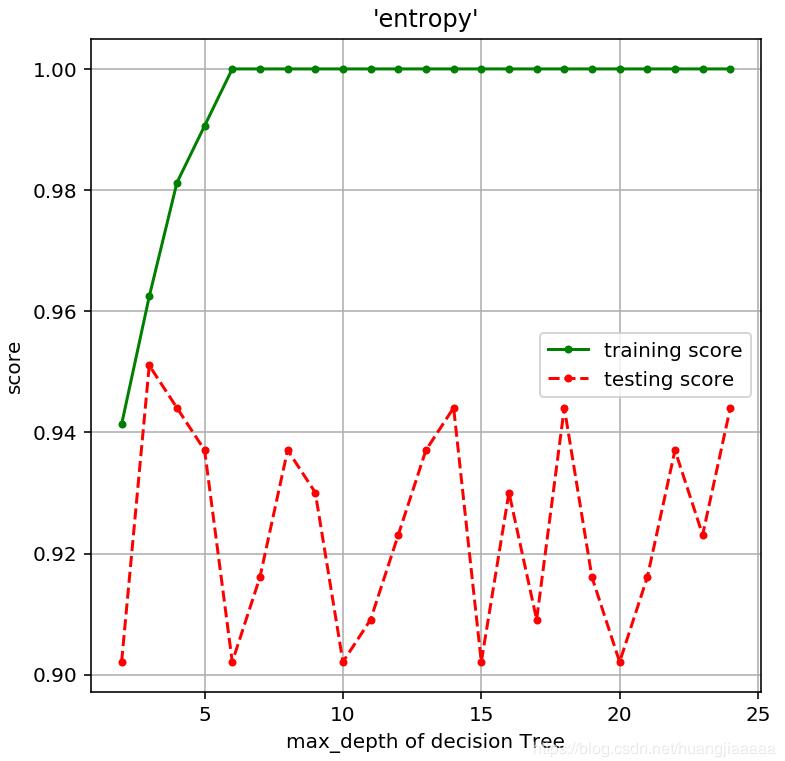您好,登录后才能下订单哦!
密码登录
登录注册
点击 登录注册 即表示同意《亿速云用户服务条款》
这期内容当中小编将会给大家带来有关使用python机器学习怎么实现决策树,文章内容丰富且以专业的角度为大家分析和叙述,阅读完这篇文章希望大家可以有所收获。
具体内容如下
# -*- coding: utf-8 -*-
"""
Created on Sat Nov 9 10:42:38 2019
@author: asus
"""
"""
决策树
目的:
1. 使用决策树模型
2. 了解决策树模型的参数
3. 初步了解调参数
要求:
基于乳腺癌数据集完成以下任务:
1.调整参数criterion,使用不同算法信息熵(entropy)和基尼不纯度算法(gini)
2.调整max_depth参数值,查看不同的精度
3.根据参数criterion和max_depth得出你初步的结论。
"""
import matplotlib.pyplot as plt
import numpy as np
import pandas as pd
import mglearn
from sklearn.model_selection import train_test_split
#导入乳腺癌数据集
from sklearn.datasets import load_breast_cancer
from sklearn.tree import DecisionTreeClassifier
#决策树并非深度越大越好,考虑过拟合的问题
#mglearn.plots.plot_animal_tree()
#mglearn.plots.plot_tree_progressive()
#获取数据集
cancer = load_breast_cancer()
#对数据集进行切片
X_train,X_test,y_train,y_test = train_test_split(cancer.data,cancer.target,
stratify = cancer.target,random_state = 42)
#查看训练集和测试集数据
print('train dataset :{0} ;test dataset :{1}'.format(X_train.shape,X_test.shape))
#建立模型(基尼不纯度算法(gini)),使用不同最大深度和随机状态和不同的算法看模型评分
tree = DecisionTreeClassifier(random_state = 0,criterion = 'gini',max_depth = 5)
#训练模型
tree.fit(X_train,y_train)
#评估模型
print("Accuracy(准确性) on training set: {:.3f}".format(tree.score(X_train, y_train)))
print("Accuracy(准确性) on test set: {:.3f}".format(tree.score(X_test, y_test)))
print(tree)
# 参数选择 max_depth,算法选择基尼不纯度算法(gini) or 信息熵(entropy)
def Tree_score(depth = 3,criterion = 'entropy'):
"""
参数为max_depth(默认为3)和criterion(默认为信息熵entropy),
函数返回模型的训练精度和测试精度
"""
tree = DecisionTreeClassifier(criterion = criterion,max_depth = depth)
tree.fit(X_train,y_train)
train_score = tree.score(X_train, y_train)
test_score = tree.score(X_test, y_test)
return (train_score,test_score)
#gini算法,深度对模型精度的影响
depths = range(2,25)#考虑到数据集有30个属性
scores = [Tree_score(d,'gini') for d in depths]
train_scores = [s[0] for s in scores]
test_scores = [s[1] for s in scores]
plt.figure(figsize = (6,6),dpi = 144)
plt.grid()
plt.xlabel("max_depth of decision Tree")
plt.ylabel("score")
plt.title("'gini'")
plt.plot(depths,train_scores,'.g-',label = 'training score')
plt.plot(depths,test_scores,'.r--',label = 'testing score')
plt.legend()
#信息熵(entropy),深度对模型精度的影响
scores = [Tree_score(d) for d in depths]
train_scores = [s[0] for s in scores]
test_scores = [s[1] for s in scores]
plt.figure(figsize = (6,6),dpi = 144)
plt.grid()
plt.xlabel("max_depth of decision Tree")
plt.ylabel("score")
plt.title("'entropy'")
plt.plot(depths,train_scores,'.g-',label = 'training score')
plt.plot(depths,test_scores,'.r--',label = 'testing score')
plt.legend()运行结果:



上述就是小编为大家分享的使用python机器学习怎么实现决策树了,如果刚好有类似的疑惑,不妨参照上述分析进行理解。如果想知道更多相关知识,欢迎关注亿速云行业资讯频道。
免责声明:本站发布的内容(图片、视频和文字)以原创、转载和分享为主,文章观点不代表本网站立场,如果涉及侵权请联系站长邮箱:is@yisu.com进行举报,并提供相关证据,一经查实,将立刻删除涉嫌侵权内容。